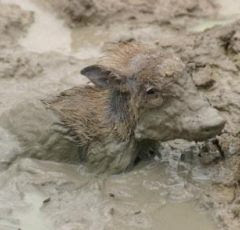Unfortunately, the warming that is occurring in our era is at least ten times faster than it was in the PETM. For this reason, it's impossible to rule out any catastrophic global warming scenario. Currently, climate models do not incorporate the effects of methane released from melting permafrost, which means even the most extreme warming scenarios the models have projected from the limited parameters they now utilize aren't extreme enough. Studies focusing on the PETM time period estimate that several thousand gton C of methane were released into the atmosphere. Recent land and sea base observations in the Siberian arctic show increased rates significantly above previous estimates.
The methane feedback loops are very serious but a spike in atmospheric methane concentration could set off abrupt catastrophic global warming. The most dangerous cause for such a spike is rapid clathrate breakdown. Clathrates [another name for methane hydrates] form when plankton and other tiny organisms in the ocean die and slowly drift to the seabed. Microorganisms feeding on the dead material emit methane. "This undersea methane bubbles up," Michael Mann writes, "but it quickly encounters the extremely cold water in the pores of the sediment. Under the high pressure of these cold depths, water and methane react to each other: water lattices link into crystalline lattices that trap methane molecules."
Sea ice, and the cold conditions it sustains, serves to stabilise methane deposits on and near the shoreline preventing the clathrate breaking down and outgassing methane into the atmosphere and causing further warming. Melting of this ice will release large quantities of methane, a powerful greenhouse gas into the atmosphere, causing further warming in a strong positive feedback loop.
According to the US Geological Survey, the seabed methane hydrate fossil fuel resource is stupefyingly vast. By a conservative estimate, it's more than two times greater than all other known fossil fuels on earth. The United States Department of Energy National Laboratory system identified potential clathrate destabilization in the Arctic as one the most serious scenarios for abrupt climate change.
Arctic methane release is only one of the serious positive feedback loops climate models ignore. They also ignore the release of methane from permafrost regions around the Arctic where stores are released by bacteria [methanogenesis] consuming the now rotting biomass. Other serious runaway climate change feedback loops ignored by climate models include the ice-albedo feedback - where the advance or retreat of ice cover alters the 'whiteness' of the earth, and its ability to absorb the sun's energy - and the dying and burning of forests.
Of all the known problems and uncertainties The Mud Report has tried to talk about recently none are more serious than the continued underestimation by the climate 'consensus' of abrupt and catastrophic climate change caused by the feedback loops that are purposefully being ignored because their effects are not easily quantifiable by the scientific mindset and their dangerous implications are uncomfortable for the corporations and the politicians they own . More serious yet though are the unknown-unknowns - black swan events caused nature's dramatic non-linear phenomena - lurking and laughing at our hubris.



